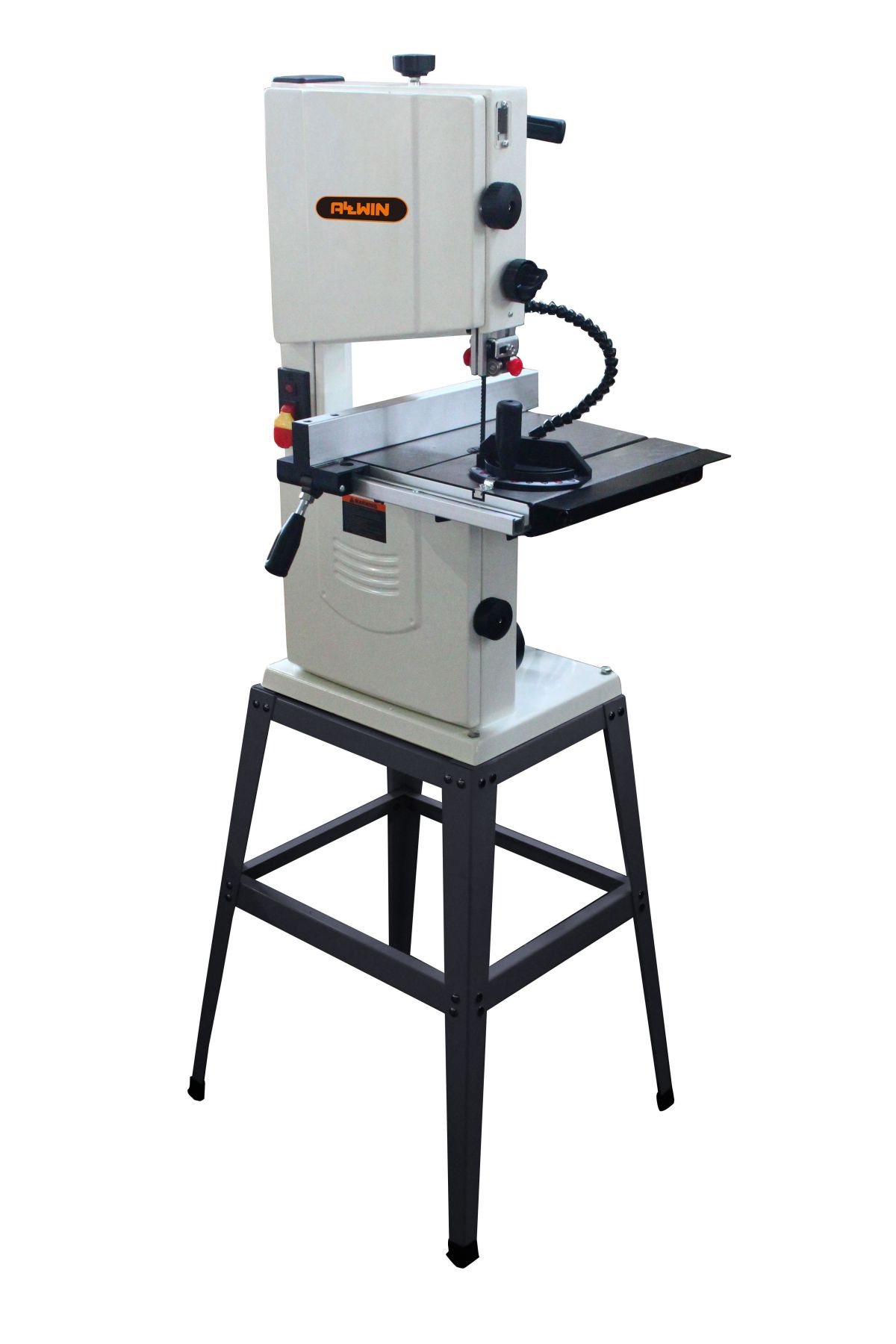ದಿಬ್ಯಾಂಡ್ ಗರಗಸಕತ್ತರಿಸುವ ಉದ್ಯಮದಲ್ಲಿ ಇದು ಅತ್ಯಂತ ಬಹುಮುಖ ಉಪಕರಣಗಳಲ್ಲಿ ಒಂದಾಗಿದೆ, ಮುಖ್ಯವಾಗಿ ದೊಡ್ಡ ವಿಭಾಗಗಳನ್ನು ಹಾಗೂ ಬಾಗಿದ ಮತ್ತು ನೇರ ರೇಖೆಗಳನ್ನು ಕತ್ತರಿಸುವ ಸಾಮರ್ಥ್ಯದಿಂದಾಗಿ. ಸರಿಯಾದದನ್ನು ಆಯ್ಕೆ ಮಾಡಲುಬ್ಯಾಂಡ್ ಗರಗಸ, ನಿಮಗೆ ಅಗತ್ಯವಿರುವ ಕತ್ತರಿಸುವ ಎತ್ತರವನ್ನು ತಿಳಿದುಕೊಳ್ಳುವುದು ಮುಖ್ಯ, ಹಾಗೆಯೇ ಬ್ಲೇಡ್ನ ಹಲ್ಲುಗಳ ಪ್ರಕಾರವನ್ನು ತಿಳಿದುಕೊಳ್ಳುವುದು ಮುಖ್ಯ, ಇದು ಕತ್ತರಿಸಬೇಕಾದ ವಸ್ತುವನ್ನು ಅವಲಂಬಿಸಿರುತ್ತದೆ. ಸಾಮಾನ್ಯವಾಗಿ, ಆಲ್ವಿನ್ಬ್ಯಾಂಡ್ ಗರಗಸಗಳುದೊಡ್ಡ ಮರದ ತುಂಡುಗಳಿಂದ ವಿಭಾಗಗಳು, ವೆನೀರ್ಗಳು, ಟೆನನ್ಗಳು ಮತ್ತು ತೆಳುವಾದ ಪಟ್ಟಿಗಳನ್ನು ಕತ್ತರಿಸಲು ತುಂಬಾ ಸೂಕ್ತವಾಗಿದೆ.
ಕತ್ತರಿಸುವ ಎತ್ತರ
ಇದು ಸಂಪೂರ್ಣವಾಗಿ ವಿಸ್ತರಿಸಿದಾಗ ಗರಗಸದ ಮೇಜು ಮತ್ತು ಮೇಲಿನ ಮಾರ್ಗದರ್ಶಿಯ ನಡುವಿನ ಅಂತರವಾಗಿದೆ ಮತ್ತು ಇದು ಕತ್ತರಿಸಬಹುದಾದ ಖಾಲಿ ಜಾಗದ ಗಾತ್ರವನ್ನು ನಿರ್ಧರಿಸುತ್ತದೆ. ಮರಗೆಲಸಗಾರನಿಗೆ ಕನಿಷ್ಠ ಆರು ಇಂಚುಗಳು (150 ಮಿಮೀ) ಇರಬೇಕು.
ಬ್ಲೇಡ್ಗಳು
ಸರಾಸರಿ ಮರಗೆಲಸ ಮಾಡುವವನು ಸಾಮಾನ್ಯವಾಗಿ ಖಾಲಿ ಜಾಗಗಳನ್ನು ತಿರುಗಿಸಲು ವೃತ್ತಗಳನ್ನು ಹರಿದು ಹಾಕುತ್ತಾನೆ ಅಥವಾ ಕತ್ತರಿಸುತ್ತಾನೆ. ಬ್ಯಾಂಡ್ ಗರಗಸದ ಬ್ಲೇಡ್ಗಳನ್ನು ಇನ್ನೂ ಸಾಮ್ರಾಜ್ಯಶಾಹಿ ಅಳತೆಯಲ್ಲಿ ವರ್ಗೀಕರಿಸಲಾಗಿದೆ. ಹಲ್ಲುಗಳನ್ನು ಹಲ್ಲುಗಳಿಗೆ ಹಲ್ಲುಗಳು (TPI) ಅಥವಾ ಪಾಯಿಂಟ್ಗಳು ಪ್ರತಿ ಇಂಚಿಗೆ (PPI) ಎಂದು ವರ್ಗೀಕರಿಸಲಾಗಿದೆ. ಹೆಬ್ಬೆರಳಿನ ನಿಯಮದಂತೆ 3TPI ಮರಗೆಲಸ ಮಾಡುವವರಿಗೆ ನಿಜವಾಗಿಯೂ ಒಳ್ಳೆಯದು. ಇದು ಹಸಿರು ಮರವನ್ನು ನಿರ್ವಹಿಸುತ್ತದೆ ಮತ್ತು ಅತಿಯಾದ ಅಡಚಣೆಯಿಲ್ಲದೆ ಮರದ ಪುಡಿಯನ್ನು ಒಯ್ಯುತ್ತದೆ.
ಮೋಟಾರ್ ಗಾತ್ರ
ಮೋಟಾರ್ ಗಾತ್ರಗಳು ½ ರಿಂದ 1 ½ HP ವರೆಗೆ ಇರುತ್ತವೆ. ಸಣ್ಣ ಗಾತ್ರದ ಮೋಟಾರ್ಗಳು ಸ್ಪಷ್ಟವಾಗಿ ಹೆಚ್ಚು ಶ್ರಮಿಸಬೇಕಾಗುತ್ತದೆ. ಆದಾಗ್ಯೂ, ನಿಮಗೆ ಅಗತ್ಯವಿರುವ ಮೋಟಾರ್ನ ಗಾತ್ರವು ನೀವು ಮಾಡುತ್ತಿರುವ ಕೆಲಸದ ಪ್ರಕಾರವನ್ನು ಅವಲಂಬಿಸಿರುತ್ತದೆ. ಕರಕುಶಲ ಕೆಲಸ ಮತ್ತು ಮುಖ್ಯವಾಗಿ ಸಾಫ್ಟ್ವುಡ್ಗಳನ್ನು ಕತ್ತರಿಸಲು, ½ ರಿಂದ 1 HP ಸಾಕು.
ಬೇಲಿ ಮತ್ತು ಗೇಜ್
ಕೆಲಸದ ಕೋಷ್ಟಕಆಲ್ವಿನ್ ಬ್ಯಾಂಡ್ ಗರಗಸಸಾಮಾನ್ಯವಾಗಿ ಲಭ್ಯವಿರುವ ಗೇಜ್ಗಳನ್ನು ಸ್ವೀಕರಿಸಲು ವಿನ್ಯಾಸಗೊಳಿಸಲಾದ ಪ್ರಮಾಣಿತ ¾” ಬೈ ⅜” ಮೈಟರ್ ಸ್ಲಾಟ್ ಅನ್ನು ಹೊಂದಿರಬೇಕು. ಬೇಲಿ ಸುಲಭವಾಗಿ ಚಲಿಸಬೇಕು ಮತ್ತು ಸುರಕ್ಷಿತವಾಗಿ ಲಾಕ್ ಆಗಬೇಕು, ಬ್ಯಾಂಡ್ಗೆ ಜೋಡಣೆಗೆ ಕನಿಷ್ಠ ಸಾಧಾರಣ ಹೊಂದಾಣಿಕೆಯನ್ನು ನೀಡಬೇಕು ಮತ್ತು ಸುಲಭವಾಗಿ ತೆಗೆಯಬೇಕು. ಮೈಟರ್ ಸ್ಲಾಟ್ ಅಥವಾ ಬ್ಲೇಡ್ಗೆ ಬೇಲಿಯನ್ನು ಸರಿಪಡಿಸುವುದು ಸುಲಭವಾಗಿರಬೇಕು.
ನೀವು ಆಸಕ್ತಿ ಹೊಂದಿದ್ದರೆ ದಯವಿಟ್ಟು "ನಮ್ಮನ್ನು ಸಂಪರ್ಕಿಸಿ" ಪುಟದಿಂದ ಅಥವಾ ಉತ್ಪನ್ನ ಪುಟದ ಕೆಳಗಿನಿಂದ ನಮಗೆ ಸಂದೇಶ ಕಳುಹಿಸಿಆಲ್ವಿನ್ ಬ್ಯಾಂಡ್ ಗರಗಸಗಳು.

ಪೋಸ್ಟ್ ಸಮಯ: ಏಪ್ರಿಲ್-11-2023


